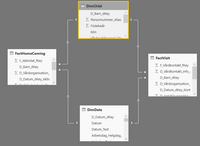Fabric Data Days starts November 4th!
Advance your Data & AI career with 50 days of live learning, dataviz contests, hands-on challenges, study groups & certifications and more!
Get registered- Power BI forums
- Get Help with Power BI
- Desktop
- Service
- Report Server
- Power Query
- Mobile Apps
- Developer
- DAX Commands and Tips
- Custom Visuals Development Discussion
- Health and Life Sciences
- Power BI Spanish forums
- Translated Spanish Desktop
- Training and Consulting
- Instructor Led Training
- Dashboard in a Day for Women, by Women
- Galleries
- Data Stories Gallery
- Themes Gallery
- Contests Gallery
- Quick Measures Gallery
- Visual Calculations Gallery
- Notebook Gallery
- Translytical Task Flow Gallery
- TMDL Gallery
- R Script Showcase
- Webinars and Video Gallery
- Ideas
- Custom Visuals Ideas (read-only)
- Issues
- Issues
- Events
- Upcoming Events
Join us at FabCon Atlanta from March 16 - 20, 2026, for the ultimate Fabric, Power BI, AI and SQL community-led event. Save $200 with code FABCOMM. Register now.
- Power BI forums
- Forums
- Get Help with Power BI
- Desktop
- Re: Using filter criteria from two different fact ...
- Subscribe to RSS Feed
- Mark Topic as New
- Mark Topic as Read
- Float this Topic for Current User
- Bookmark
- Subscribe
- Printer Friendly Page
- Mark as New
- Bookmark
- Subscribe
- Mute
- Subscribe to RSS Feed
- Permalink
- Report Inappropriate Content
Using filter criteria from two different fact tables.
Hi.
I'm having a problem creating a measure that counts "How many children have had a visit within 14 days after homecoming"
In my model I have one fact table with the "homecoming" events and another fact table with the visits.
In SQL I would have solved it by using Exists like this.
... ,count(distinct fv.d_barn_dkey) FROM FactVisit fv ... AND EXISTS ( select NULL from FactHomecoming f where f.D_Aktivitetskod_dKey = 10 AND fv.D_Barn_dKey = f.D_Barn_dKey AND fv.VisitDate <= DATEADD(dd,14,f.HomecomingDate) )
But how do I create the Measure?
CountChildrenWithVisitsWithin14daysAfterHomecoming:=
CALCULATE(
DISTINCTCOUNT('FactVisit'[D_Barn_dKey])
;Filter1
;Filter2
/*;Missing filter FactVisit[VisitDate] <= FactHomeComing[HomecomingDate] + 14 days */
)
Solved! Go to Solution.
- Mark as New
- Bookmark
- Subscribe
- Mute
- Subscribe to RSS Feed
- Permalink
- Report Inappropriate Content
So I think I've solved it.
Just for the record: There should be just one homecoming date per child.
To be able to compare the two dates from the two fact tables I created two calculated columns in DimChild.
First one like this.
HomecommingDate =
CALCULATE(
MIN('F_Homecomming'[ActivityDate].[Date]);
)
The other one (because I wasn't able to solve it in the first step) like this.
HomecommingDate_Plus14Days =
DATEADD('D_Child'[HomecommingDate].[Date];14;DAY)
Then I used this calculated column in the comparsion when creating the measure.
CALCULATE(
DISTINCTCOUNT('F_Visit'[D_Child_dKey])
;...
;'...
;FILTER('F_Visit';
'F_Visit'[VisitDate] <= RELATED('D_Child'[HomecommingDate_Plus14Days])
)
)
Feel free to comment if there is a better way of doing it...
Cheers
- Mark as New
- Bookmark
- Subscribe
- Mute
- Subscribe to RSS Feed
- Permalink
- Report Inappropriate Content
So I think I've solved it.
Just for the record: There should be just one homecoming date per child.
To be able to compare the two dates from the two fact tables I created two calculated columns in DimChild.
First one like this.
HomecommingDate =
CALCULATE(
MIN('F_Homecomming'[ActivityDate].[Date]);
)
The other one (because I wasn't able to solve it in the first step) like this.
HomecommingDate_Plus14Days =
DATEADD('D_Child'[HomecommingDate].[Date];14;DAY)
Then I used this calculated column in the comparsion when creating the measure.
CALCULATE(
DISTINCTCOUNT('F_Visit'[D_Child_dKey])
;...
;'...
;FILTER('F_Visit';
'F_Visit'[VisitDate] <= RELATED('D_Child'[HomecommingDate_Plus14Days])
)
)
Feel free to comment if there is a better way of doing it...
Cheers
- Mark as New
- Bookmark
- Subscribe
- Mute
- Subscribe to RSS Feed
- Permalink
- Report Inappropriate Content
A small correction.
I've changed the formula when creating the calculated column
HomecommingDate_Plus14Days =DATEADD('D_Child'[HomecommingDate].[Date];14;DAY)
to
HomecommingDate_Plus14Days = 'D_Child'[HomecommingDate].[Date] + 14
because the strange behavior of the DATEADD that gaved me BLANK values on some rows instead of the new date.
The new calculated date must exists as a value in the original column (HomecommingDate) otherwize it turns to BLANK.
Read more here: https://blog.crossjoin.co.uk/2012/01/06/the-dax-dateadd-function-and-missing-dates/
- Mark as New
- Bookmark
- Subscribe
- Mute
- Subscribe to RSS Feed
- Permalink
- Report Inappropriate Content
Hi @Pelle,
Thanks for your sharing. Would you please mark your sharing solution as an answer so that it can benefit more users?
Regards,
Yuliana Gu
If this post helps, then please consider Accept it as the solution to help the other members find it more quickly.
Helpful resources

FabCon Global Hackathon
Join the Fabric FabCon Global Hackathon—running virtually through Nov 3. Open to all skill levels. $10,000 in prizes!

Power BI Monthly Update - October 2025
Check out the October 2025 Power BI update to learn about new features.

| User | Count |
|---|---|
| 85 | |
| 42 | |
| 30 | |
| 27 | |
| 27 |

